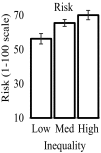Economic inequality increases risk taking
- PMID: 28416655
- PMCID: PMC5422783
- DOI: 10.1073/pnas.1616453114
Economic inequality increases risk taking
Abstract
Rising income inequality is a global trend. Increased income inequality has been associated with higher rates of crime, greater consumer debt, and poorer health outcomes. The mechanisms linking inequality to poor outcomes among individuals are poorly understood. This research tested a behavioral account linking inequality to individual decision making. In three experiments (n = 811), we found that higher inequality in the outcomes of an economic game led participants to take greater risks to try to achieve higher outcomes. This effect of unequal distributions on risk taking was driven by upward social comparisons. Next, we estimated economic risk taking in daily life using large-scale data from internet searches. Risk taking was higher in states with greater income inequality, an effect driven by inequality at the upper end of the income distribution. Results suggest that inequality may promote poor outcomes, in part, by increasing risky behavior.
Keywords: decision making; income inequality; inequality; risk taking; socioeconomic status.
Conflict of interest statement
Conflict of interest statement: The authors acknowledge funding from the Spencer Foundation.
Figures






Comment in
-
Reply to van Hoorn: Social comparisons of "enough" are an informational signal.Proc Natl Acad Sci U S A. 2017 Jun 20;114(25):E4900. doi: 10.1073/pnas.1707044114. Epub 2017 Jun 12. Proc Natl Acad Sci U S A. 2017. PMID: 28607040 Free PMC article. No abstract available.
-
Informational content of relative deprivation as a channel linking economic inequality to risk taking.Proc Natl Acad Sci U S A. 2017 Jun 20;114(25):E4899. doi: 10.1073/pnas.1706625114. Epub 2017 Jun 12. Proc Natl Acad Sci U S A. 2017. PMID: 28607041 Free PMC article. No abstract available.
Similar articles
-
Inequality and visibility of wealth in experimental social networks.Nature. 2015 Oct 15;526(7573):426-9. doi: 10.1038/nature15392. Epub 2015 Sep 9. Nature. 2015. PMID: 26352469
-
The greater the economic inequality, the later people have children: The association between economic inequality and reproductive timing.Scand J Psychol. 2020 Jun;61(3):450-459. doi: 10.1111/sjop.12612. Epub 2020 Feb 3. Scand J Psychol. 2020. PMID: 32012300
-
Income inequality and status seeking: searching for positional goods in unequal U.S. States.Psychol Sci. 2015 Apr;26(4):527-33. doi: 10.1177/0956797614567511. Epub 2015 Mar 19. Psychol Sci. 2015. PMID: 25792131
-
Population health in an era of rising income inequality: USA, 1980-2015.Lancet. 2017 Apr 8;389(10077):1475-1490. doi: 10.1016/S0140-6736(17)30571-8. Lancet. 2017. PMID: 28402829 Review.
-
Socioeconomic disparities and health: impacts and pathways.J Epidemiol. 2012;22(1):2-6. doi: 10.2188/jea.je20110116. Epub 2011 Dec 10. J Epidemiol. 2012. PMID: 22156290 Free PMC article. Review.
Cited by
-
When are people more open to cheating? Economic inequality makes people expect more everyday unethical behavior.PLoS One. 2024 Feb 21;19(2):e0294124. doi: 10.1371/journal.pone.0294124. eCollection 2024. PLoS One. 2024. PMID: 38381751 Free PMC article.
-
Selective insensitivity to income held by the richest.PNAS Nexus. 2024 Sep 17;3(9):pgae333. doi: 10.1093/pnasnexus/pgae333. eCollection 2024 Sep. PNAS Nexus. 2024. PMID: 39290440 Free PMC article.
-
Why are some countries rich and others poor? development and validation of the attributions for Cross-Country Inequality Scale (ACIS).PLoS One. 2024 Feb 27;19(2):e0298222. doi: 10.1371/journal.pone.0298222. eCollection 2024. PLoS One. 2024. PMID: 38412193 Free PMC article.
-
Dress is a Fundamental Component of Person Perception.Pers Soc Psychol Rev. 2023 Nov;27(4):414-433. doi: 10.1177/10888683231157961. Epub 2023 Mar 23. Pers Soc Psychol Rev. 2023. PMID: 36951208 Free PMC article. Review.
-
Examining the replicability of online experiments selected by a decision market.Nat Hum Behav. 2025 Feb;9(2):316-330. doi: 10.1038/s41562-024-02062-9. Epub 2024 Nov 19. Nat Hum Behav. 2025. PMID: 39562799 Free PMC article.
References
-
- Saez E, Zucman G. Wealth inequality in the United States since 1913: Evidence from capitalized income tax data. Q J Econ. 2016;131:519–578.
-
- Choe J. Income inequality and crime in the United States. Econ Lett. 2008;101:31–33.
-
- Freund E, Morris I. Gambling and income inequality in the states. Policy Stud J. 2006;34:265–276.
-
- Frank R. Falling Behind: How Rising Inequality Harms the Middle Class. Univ of California Press; Berkeley, CA: 2013.
-
- Kawachi I, Subramanian SV. 2014. Income inequality. Social Epidemiology, eds Berkman LF, Kawachi I, Glymour M (Oxford Univ Press, New York), 126–152.
Publication types
MeSH terms
LinkOut - more resources
Full Text Sources
Other Literature Sources

